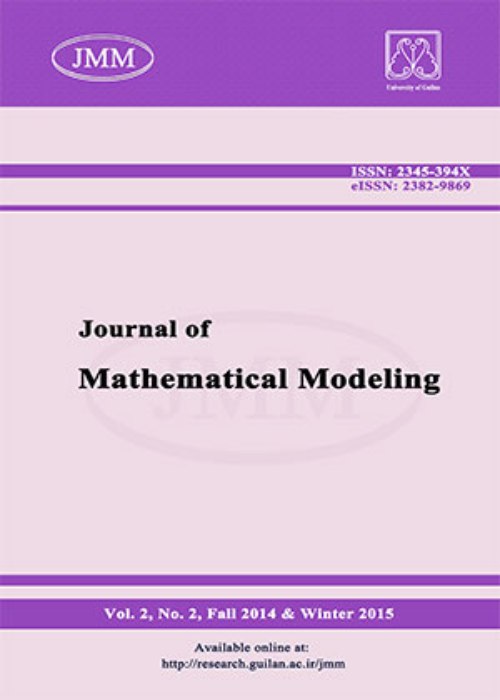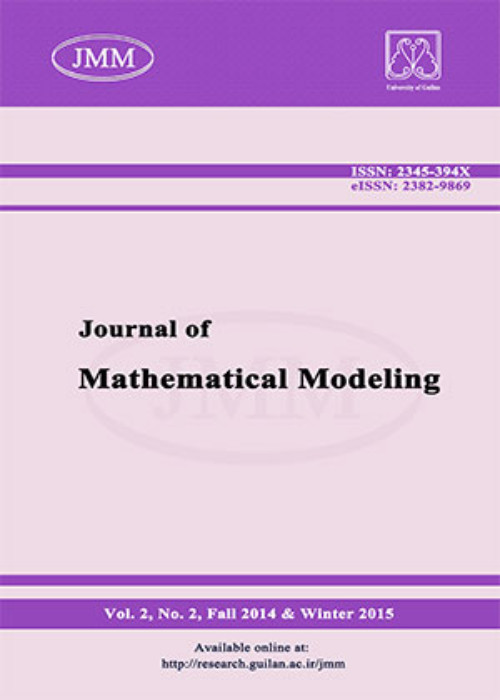فهرست مطالب

Journal of Mathematical Modeling
Volume:11 Issue: 2, Spring 2023
- تاریخ انتشار: 1402/04/10
- تعداد عناوین: 12
-
-
Pages 207-228This paper presents a covering algorithm for solving bound-constrained global minimization problems with a differentiable cost function. In the proposed algorithm, we suggest to explore the feasible domain using a one-dimensional global search algorithm through a number of parametric curves that are relatively spread and simultaneously scan the search space. To accelerate the corresponding algorithm, we incorporate a multivariate quasi-Newton local search algorithm to spot the lowest regions. The proposed algorithm converges in a finite number of iterations to an $\varepsilon$-approximation of the global minimum. The performance of the algorithm is demonstrated through numerical experiments on some typical test functions.Keywords: Global optimization, Alienor dimensionality reduction technique, One-dimensional global search algorithm, Limited Memory BFGS-B algorithm
-
Pages 229-244In this paper, we aim to propose a new hybrid version of the Longstaff and Schwartz algorithm under the exponential Levy Jump-diffusion model using Random Forest regression. For this purpose, we will build the evolution of the option price according to the number of paths. Further, we will show how this approach numerically depicts the convergence of the option price towards an equilibrium price when the number of simulated trajectories tends to a large number. In the second stage, we will compare this hybrid model with the classical model of the Longstaff and Schwartz algorithm (as a benchmark widely used by practitioners in pricing American options) in terms of computation time, numerical stability and accuracy. At the end of this paper, we will test both approaches on the Microsoft share “MSFT” as an example of a real market.Keywords: Monte Carlo simulation, Levy jump-diffusion model, Longstaff, Schwartz algorithm, American option, Random Forest RI regression, Microsoft ``MSFT put option, Dynamic programming
-
Pages 245-255In this paper, we consider a fourth order mixed partial differential equation with some initial and boundary conditions which is unsolvable by classical methods such as Fourier, Fourier-Bircove and Laplace Transformation methods. For this problem we will apply the contour integral and asymptotic methods. The convergence of the appeared integrals, existence and uniqueness of solution, satisfying the solution and holding the given initial and boundary conditions are stablished by complex analysis theory and related contour integrals. Finally, the form of analytic and approximate solutions are given due to different cases of eigenvalues distributions in the complex plane.Keywords: Asymptotic method, Laplace line, Eigenvalues, Contour integral
-
Pages 257-275In this paper, we propose a new approach to solve weakly singular fractional delay integro-differential equations. In the proposed approach, we apply the operational matrices of fractional integration and delay function based on the shifted Chebyshev polynomials to approximate the solution of the considered equation. By approximating the fractional derivative of the unknown function as well as the unknown function in terms of the shifted Chebyshev polynomials and substituting these approximations into the original equation, we obtain a system of nonlinear algebraic equations. We present the convergence analysis of the proposed method. Finally, to show the accuracy and validity of the proposed method, we give some numerical examples.Keywords: Operational matrices, fractional delay integro-differential equation, Weakly singular kernel
-
Pages 277-300The substitution box (S-Box) is a critical component in symmetric cipher algorithms. In this paper, we choose the Hindmarsh-Rose system to generate chaotic S-Boxes. We propose two S-Boxes based on the rotation algorithm relative to the rows (or columns) and the other based on the Zigzag transformation. The performance of the new S-Boxes is evaluated by bijective, nonlinearity, strict avalanche criterion (SAC), output bits independence criterion (BIC), differential approximation probability, linear approximation probability, and algebraic degree. The analysis results show that the presented S-Boxes have suitable cryptographic properties. Also, an image encryption algorithm based on two proposed S-Boxes, and a chaotic Hindmarsh-Rose system are presented. Experimental results show the recommended method has attained good security, and the suggested plan has potent resistance to different attacks.Keywords: S-Box, chaotic Hindmarsh-Rose system, image encryption, image analysis
-
Pages 301-322We discuss some potential advantages of the orthogonal symmetric-diagonal reduction in two main versions of the Schur-QR method for symmetric positive definite generalized eigenvalue problems. We also advise and use the appropriate reductions as preprocessing on the solvers, mainly the Cholesky-QR method, of the considered problems. We discuss numerical stability of the methods via providing upper bound for backward error of the computed eigenpairs and via investigating two kinds of scaled residual errors. We also propose and apply two kinds of symmetrizing which improve the stability and the performance of the methods. Numerical experiments show that the implemented versions of the Schur-QR method and the preprocessed versions of the Cholesky-QR method are usually more stable than the Cholesky-QR method.Keywords: Symmetric definite generalized eigenvalue problem, Cholesky-QR method, Schur-QR method, QZ method, rounding error analysis
-
Pages 323-342A new version of the augmented self-scaling memoryless BFGS quasi-Newton update, proposed in [Appl. Numer. Math. 167, 187--201, (2021)], is suggested for unconstrained optimization problems. To use the corresponding scaled parameter, the clustering of the eigenvalues of the approximate Hessian matrix about one point is applied with three approaches. The first and second approaches are based on the trace and the determinant of the matrix. The third approach is based on minimizing the measure function. The sufficient descent property is guaranteed for uniformly convex functions, and the global convergence of the proposed algorithm is proved both for the uniformly convex and general nonlinear objective functions, separately. Numerical experiments on a set of test functions of the CUTEr collection show that the proposed method is robust. In addition, the proposed algorithm is effectively applied to the salt and pepper noise elimination problem.Keywords: Unconstrained optimization, augmented BFGS, noise elimination problem
-
Pages 343-355In this paper, we intend to introduce the Sturm-Liouville fractional problem and solve it using the collocation method based on Chebyshev cardinal polynomials. To this end, we first provide an introduction to the Sturm-Liouville fractional equation. Then the Chebyshev cardinal functions are introduced along with some of their properties and the operational matrices of the derivative, fractional integral, and Caputo fractional derivative are obtained for it. Here, for the first time, we solve the equation using the operational matrix of the fractional derivative without converting it to the corresponding integral equation. In addition to efficiency and accuracy, the proposed method is simple and applicable. The convergence of the method is investigated, and an example is presented to show its accuracy and efficiency.Keywords: collocation method, fractional Sturm-Liouville eigenvalue problem, Chebyshev cardinal functions
-
Pages 357-373In this work, we present a new version of the Cahn-Hilliard equation to deal with binary image inpainting. The proposed model is unique due to its memory effect ability implemented by the time fractional derivative. Also, this model has a new diffusion term that gives a topological reconnection and a well sharpness of edges and corners. We give an existence result with some numerical tests implemented by the convexity splitting to show the efficiency of the proposed model.Keywords: Image inpainting, Cahn-Hilliard equation, time-fractional, Caputo derivative, finite difference, convexity splitting
-
Pages 375-394The main purpose of this paper is to study dynamics of stochastic chemostat model. In this order, Taylor expansions, polar coordinate transformation and stochastic averaging method are our main tools. The stability and bifurcation of the stochastic chemostat model are considered. Some theorems provide sufficient conditions to investigate stochastic stability, $D$-bifurcation and $P$-bifurcation of the model. As a final point, to show the effects of the noise intensity and illustrate our theoretical results, some numerical simulations are presented.Keywords: Stochastic chemostat model, Lyapunov exponent, D-bifurcation, P-bifurcation
-
Pages 395-410This paper presents a parameter-uniform numerical scheme for the solution of two-parameter singularly perturbed parabolic convection-diffusion problems with a delay in time. The continuous problem is semi-discretized using the Crank-Nicolson finite difference method in the temporal direction. The resulting differential equation is then discretized on a uniform mesh using the fitted operator finite difference method of line scheme. The method is shown to be accurate in $ O(\left(\Delta t \right)^{2} + N^{-2}) $, where $ N $ is the number of mesh points in spatial discretization and $ \Delta t $ is the mesh length in temporal discretization. The parameter-uniform convergence of the method is shown by establishing the theoretical error bounds. Finally, the numerical results of the test problems validate the theoretical error bounds.Keywords: Singular perturbation, time-delayed parabolic convection-diffusion problems, two small parameters, the method of line, finite difference scheme, uniform convergence
-
Pages 411-423In this article, a class of singularly perturbed nonlinear differential equations with Robin boundary conditions is considered. A numerical method consists of the classical finite difference operator over a Shishkin mesh with two-mesh algorithm is constructed to solve the problems. The method is proved to be first order convergent uniformly with respect to the perturbation parameter. Experiments are carried out for two different types of Robin boundary conditions and Neumann boundary conditions as a special case of Robin boundary conditions.Keywords: Singular perturbation problems, Robin boundary conditions, Nonlinear differential equations, finite difference scheme, Shishkin mesh, parameter-uniform convergence


